School Safety, Preparedness, & Reopening
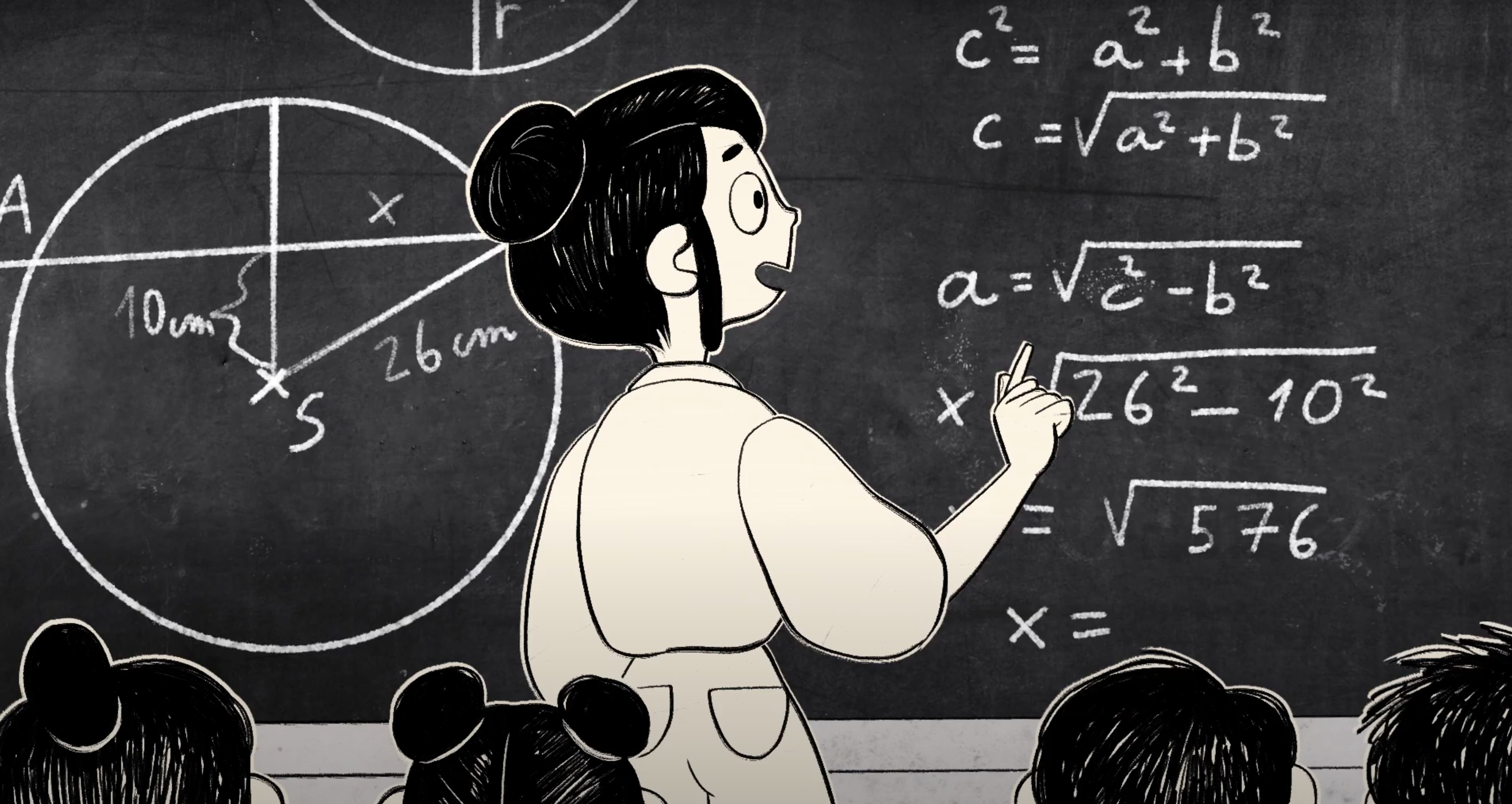
COVID-19 continues to disrupt learning for over 325 million children in East Asia and the Pacific.
As variants of the disease take hold in many countries, governments must heed the lessons learned from previous and ongoing COVID-19 responses.
While there will be difficult challenges ahead, this moment should also act as a trigger to reimagine the way children learn, no matter who or where they are.
It is a time for governments to shine.
We should not go back to what was. Even before school closures, far too many children were being left behind.
That is why this is the time to protect and reimagine education systems.

Closures lead to massive learning & economic losses
In 2020, many countries closed schools in response to COVID-19, despite evidence indicating that schools are not a significant driver of the pandemic.
During this time, alternative learning measures were in place through the internet, television, radio, and print. Yet, remote learning was out of reach for at least 80 million children, serving to amplify existing inequalities further.
These were children who do not have internet access, personal computers, TVs or even radio at home.
These are the children already being left behind in many places: the most impoverished, those with disabilities, those affected by migration, and those from minority ethnic and linguistic groups.
With every day that goes by under new closures, more and more children will fall further behind.
We cannot let this happen again.

Seeds of opportunity

UNICEF is working with partners across the region to respond to the COVID-19 emergency, and part of the response entails ensuring every child continues to learn.
We cannot let today’s crisis become a crisis for generations to come, which is why we are asking governments to continue investments in education and use this crisis as an opportunity to reimagine and rethink how children from all walks of life can learn.
There is no better investment than education and governments must act today to safeguard the future of the next generation.
Unless mitigation measures are implemented, the World Bank estimates a loss of $10 trillion in earnings over time for this entire generation of students.
For the Asian Development Bank (ADB), the value of these losses is estimated at $1.25 trillion for developing Asia, equivalent to 5.4 per cent of the region’s 2020 gross domestic product (GDP). Existing evidence shows the cost of addressing learning gaps are lower and more effective when they are tackled earlier, and that investments in education support economic recovery, growth and prosperity.
To compound the issue further, children and their parents and teachers have faced increased levels of anxiety and stress due to isolation, uncertainty, and fear of the future.
But there is a way to recover and rebound from this crisis.
While we are in a difficult period, putting more people into hardship and laying bear the difficult situation of millions of children already in poverty in the region, it is also creating new ideas and opportunities to close the educational divide.
Seeds of opportunity are beginning to sprout.
What we are seeing across East Asia & Pacific is that when faced with crisis, individuals and governments have the ability to rebound and reimagine how education can work for children.
A time to recover lost learning.
A time to rethink teaching & learning.
A time to reimagine education.
For every child.
Actions to take
Reopen schools as soon as safe to do so
Reopening schools cannot wait for all teachers and students to be vaccinated. With the global vaccine shortages plaguing low and middle-income countries, vaccinating frontline workers and those most at risk of severe illness and death will remain a priority.
Protect education budgets
While national budgets tighten, it is important to protect education from budget cuts. This will safeguard the investments and huge progress already achieved in recent decades – and protect children’s futures.
Alternative learning solutions
Not every child can get online, and not every school can be open safely, therefore innovative learning solutions should be created with local communities and parents.
Boost investment in teachers
Give teachers the skills and knowledge to better adapt to the new normal, with digital skills and managing home learning.
Catch-up programmes
Create programmes to help children catch-up from lost learning and consider adjusting the academic calendar to make up for lost time
Prioritize wellbeing
Education, safety, friends, and food have been replaced in some cases by anxiety, violence, and teenage pregnancy. Education needs to focus on health, nutrition, mental health and protection services.
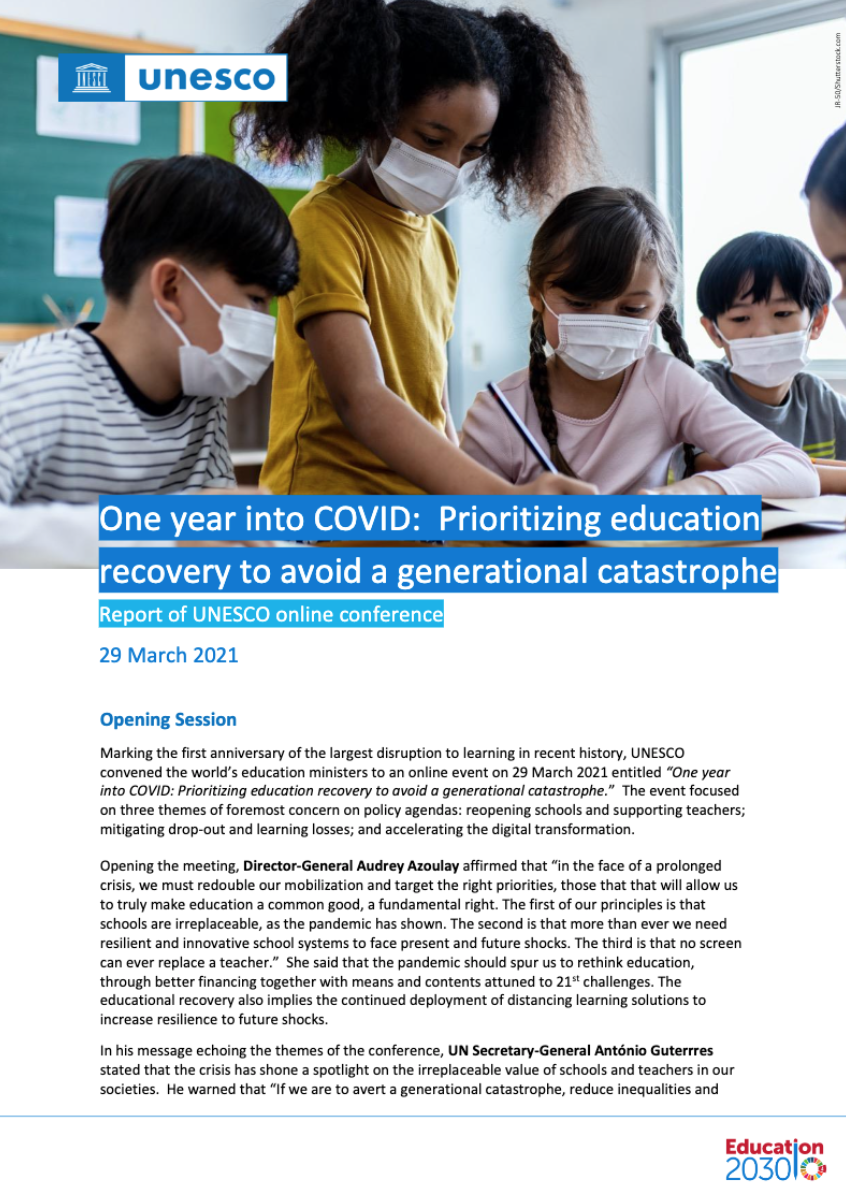
Author: UNESCO
Audience: Policymakers
Languages: English
Geographical Scope: Regional
During the pandemic, the majority of governments (133 countries) provided a mix of online, television and radio solutions to ensure learning continuity, providing strong ground to build more resilient education systems and bridge the digital divide. However, we are just beginning to obtain a global picture of learning loss: according to a study by the UNESCO Institute for Statistics, 100 million children and youth are projected to fall below the minimum proficiency level in reading because of COVID-19, erasing gains made over the past two decades. Ms Gianninistressed the importance of protecting teachers, including by making them a priority group in vaccination campaigns, and reiterated the call to protect education finance. According to the joint Education Finance Watch Study with the World Bank, 65% of low-income countries are cutting education budgets while education only accounts for 2% allocation in stimulus packages of 56 countries. Finally,she referred to the achievements of the Global Education Coalition, marking its first anniversary, noting its actions in 100 countries and missions around skills, teachers and connectivity.
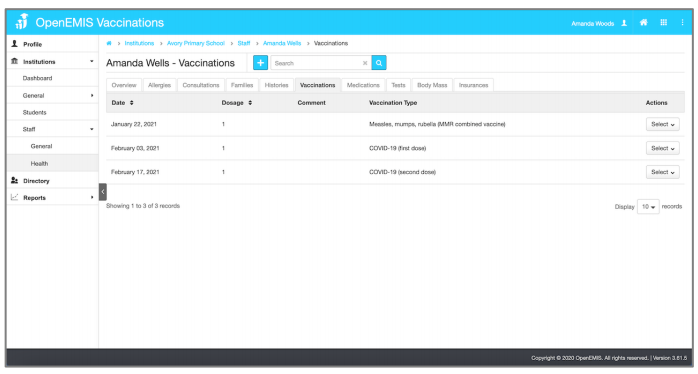
Author: UNESCO and Community Systems Foundation
Audience: Policymakers and Teachers
Languages: English
Geographical Scope: Regional
A sector wide Open Source Education Management Information System (EMIS) that facilitates the collection, processing and management of student and staff health information. OpenEMIS Vaccinations is a customizable web application that supports the activities involved in managing individual student and staff health tests and vaccinations.
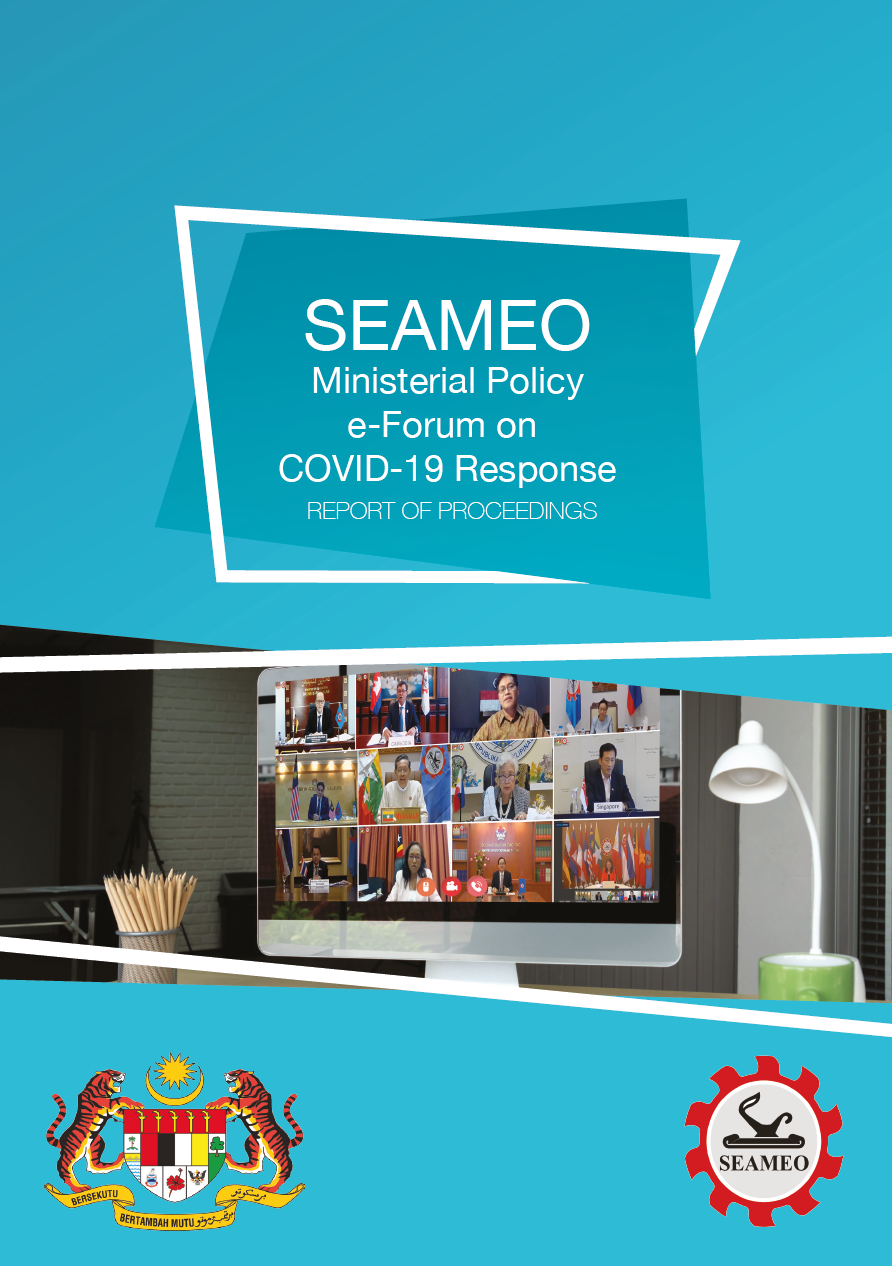
Author: SEAMEO Secretariat
Audience: Policymakers and General Public
Languages: English
Geographical Scope: Southeast Asia Region
The presentations of the Education Ministers focused on five essential elements—the immediate actions they have taken when education was disrupted, the alternative modalities they chose to ensure that learning continued at home, the evolving roles of teachers and parents in educating learners, the efforts they put in place to reach the disadvantaged and vulnerable, and the educational policies they enacted with regard to school reopening. Best practices, lessons learned, reflections, and positive discoveries were also shared in an effort to address the challenges brought on by the COVID-19 pandemic that caused unprecedented school lock-downs.
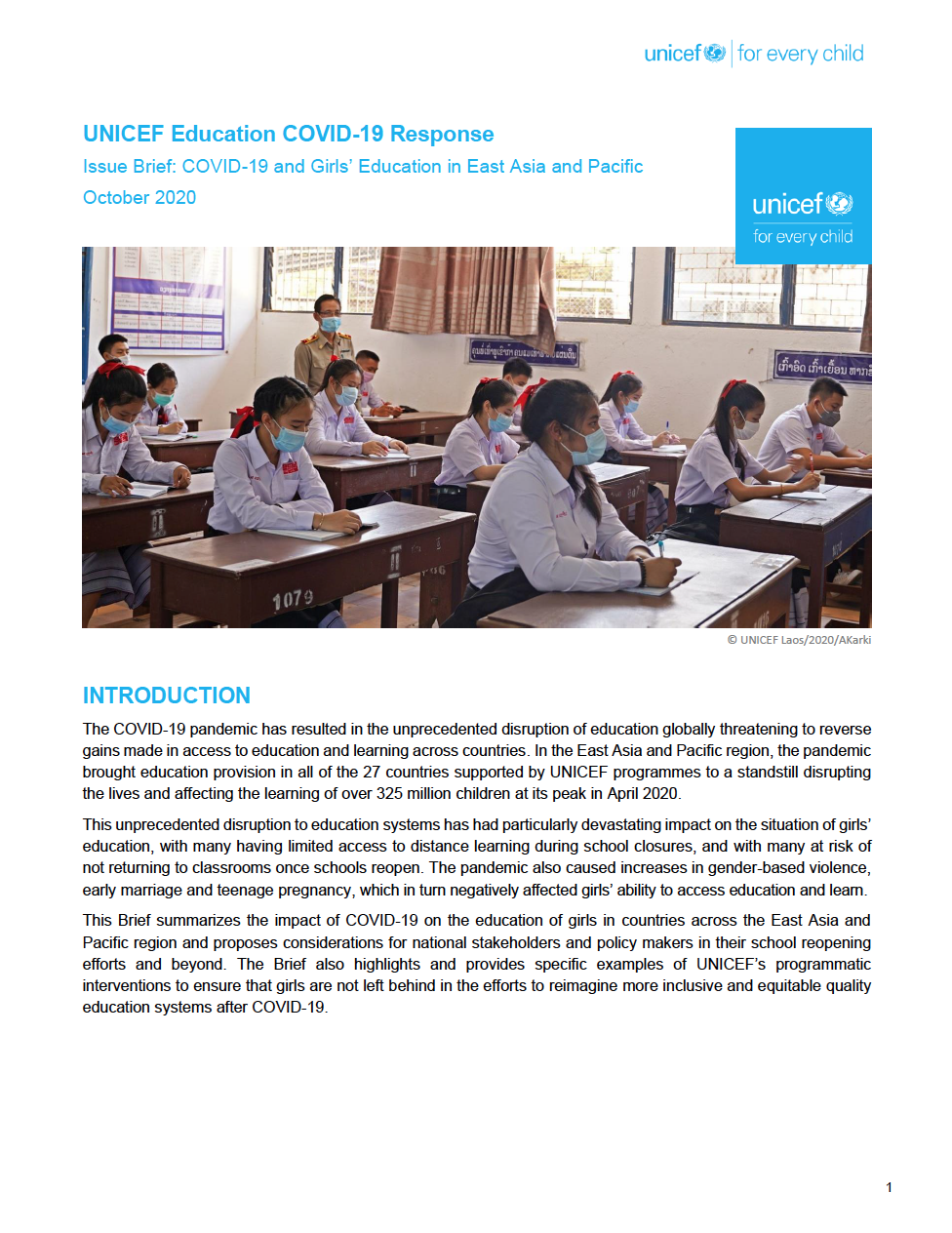
Author: UNESCO
Audience: Policymakers
Languages: English
Geographical Scope: East Asia and Pacific
This Brief summarizes the impact of COVID-19 on the education of girls in countries across the East Asia and Pacific(EAP) region and proposes considerations for national stakeholders and policy makers in their school reopening efforts and beyond. The Brief also provides specific examples of UNICEF’s programmatic interventions for ensuring girls are not left behind.
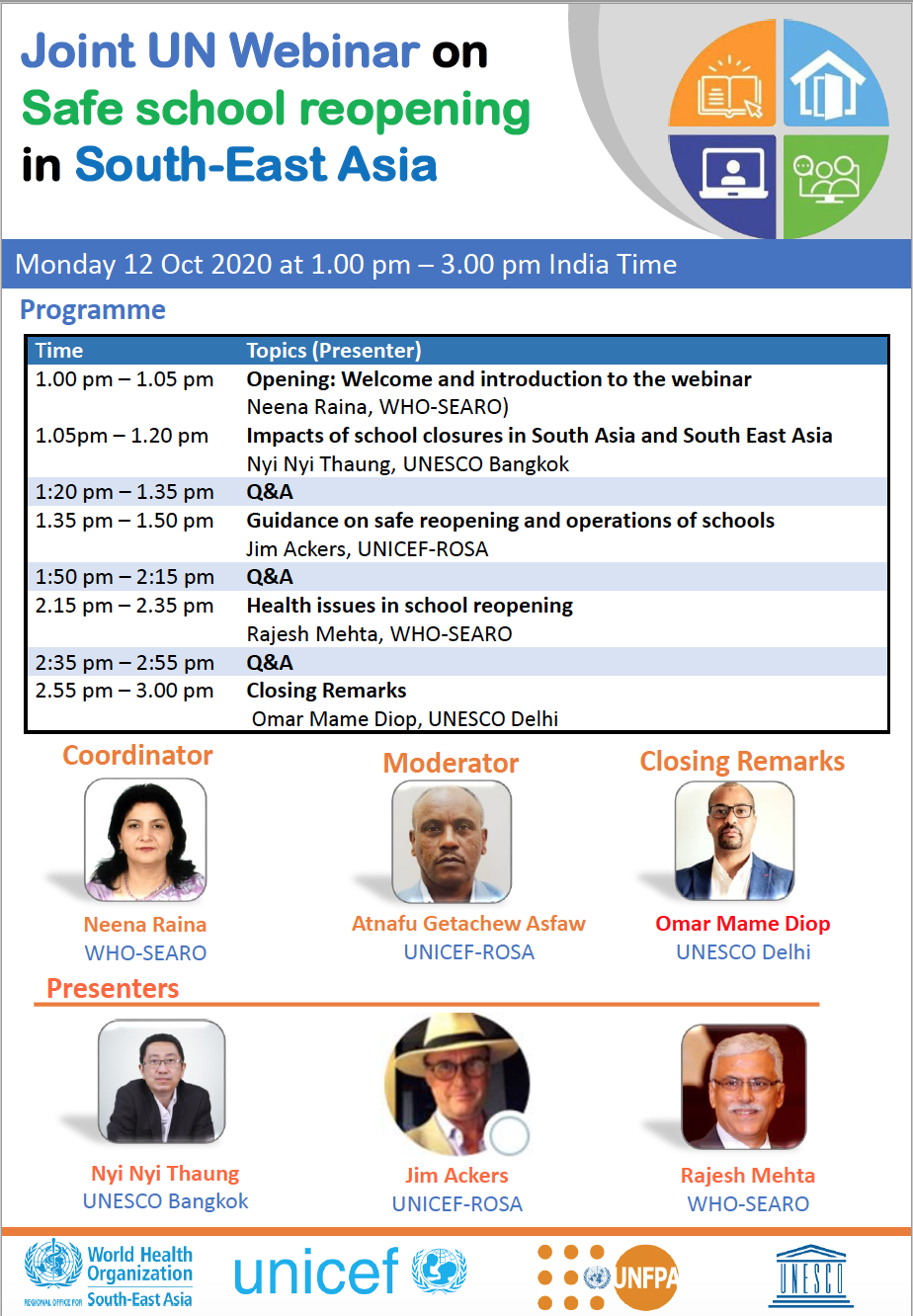
Author: UNESCO, UNICEF and WHO-SEARO
Audience: Policymakers
Languages: English
Geographical Scope: South-East Asia
The first in a series of joint UN webinars designed for representatives of Ministry of Education and Ministry of Health with the following objectives:
- Share knowledge and deliberate on available global guidelines for school re-opening and safe school operations
- Enhance collaboration between health and education stakeholders for this common agenda
- Facilitate experience-sharing among countries in South Asia and South-East Asia
Participants were from 12 countries across Asia and the Pacific region namely Afghanistan, Bangladesh, Bhutan, India, the Maldives, Nepal, Pakistan, Sri Lanka, Indonesia, Myanmar, Thailand and Timor-Leste.
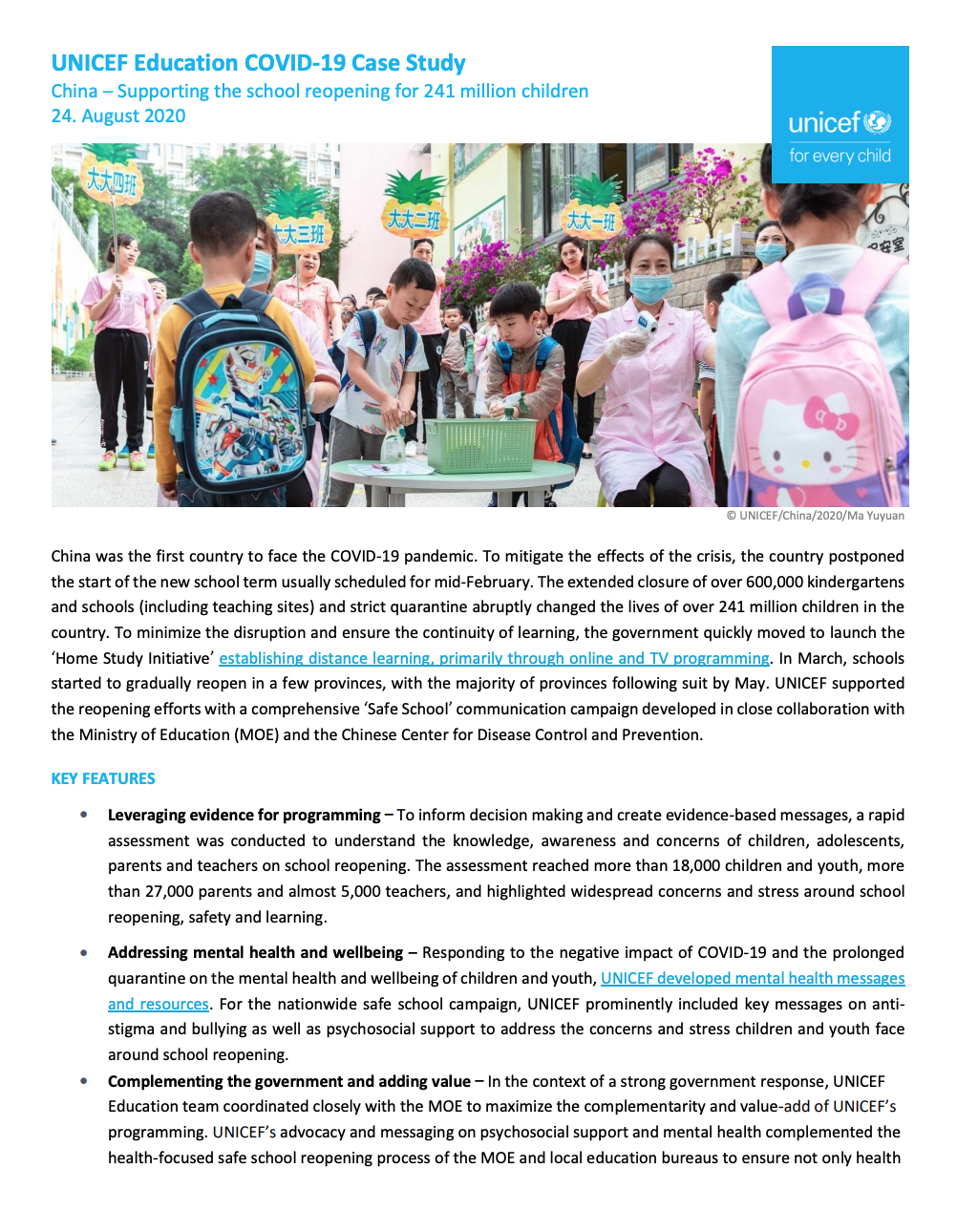
Author: UNICEF
Audience: Policymakers and General Public
Languages: English
Geographical Scope: China
UNICEF supported the reopening efforts with a comprehensive ‘Safe School’ communication campaign developed in close collaboration with the Ministry of Education (MOE) and the Chinese Center for Disease Control and Prevention.
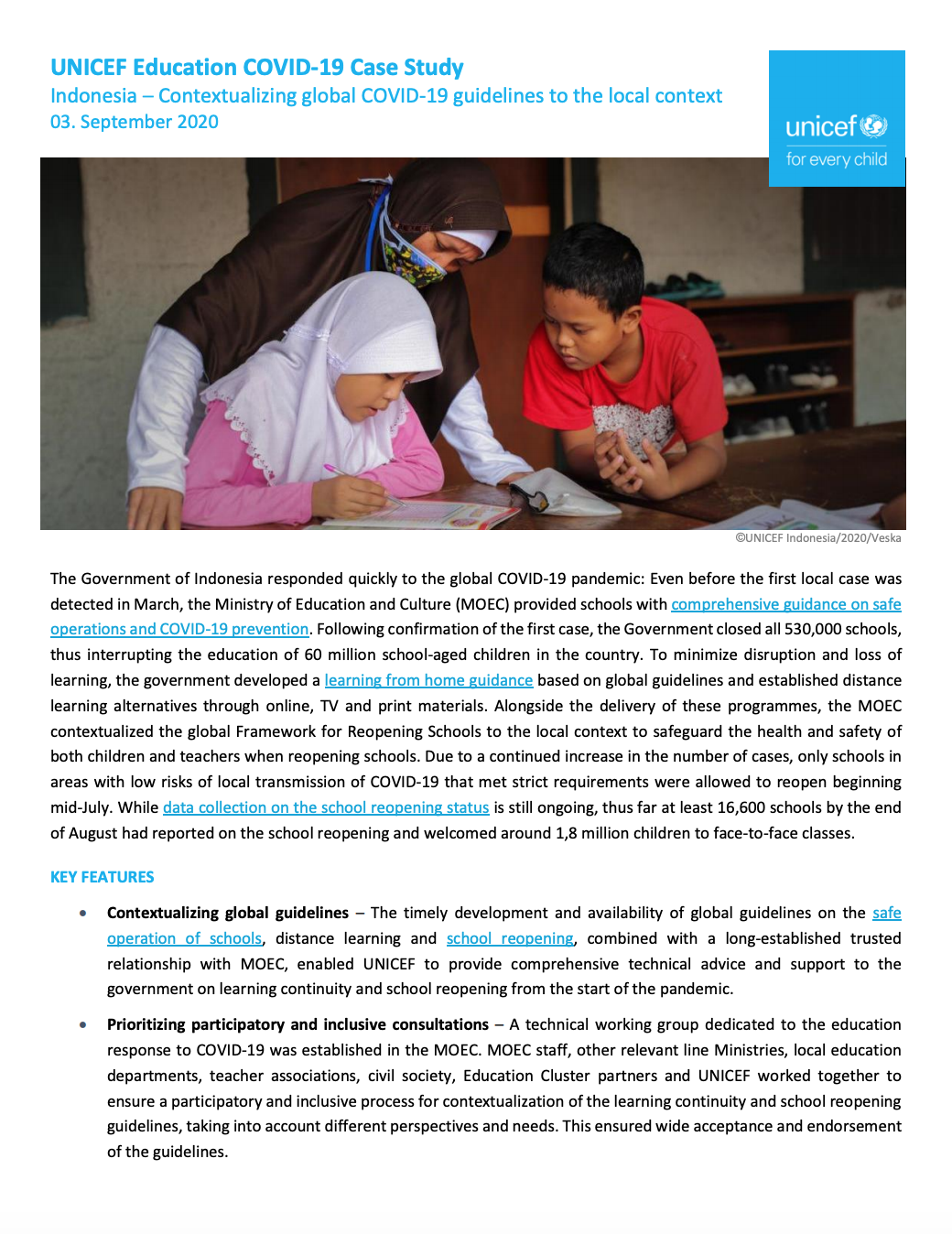
Author: UNICEF
Audience: Policymakers and General Public
Languages: English
Geographical Scope: Indonesia
The Government of Indonesia responded quickly to the global COVID-19 pandemic: Even before the first local case was detected in March, the Ministry of Education and Culture (MOEC) provided schools with comprehensive guidance on safe operations and COVID-19 prevention.
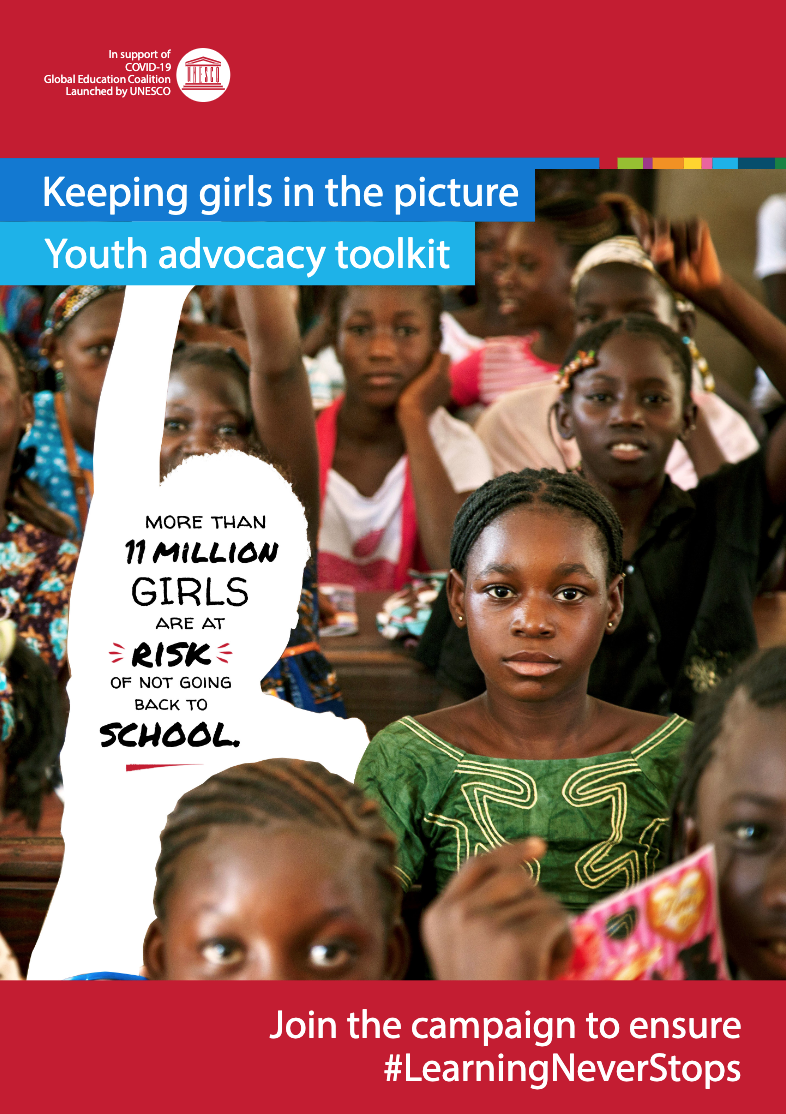
Author: UNESCO and Global Education Coalition
Audience: Policymakers
Languages: English
Geographical Scope: Regional
The campaign calls for efforts to safeguard progress made on girls’ education, ensure girls’ learning continuity during school closures, and promote girls’ safe return to school once these reopen. It also sheds light on the 130 million girls who were already out of school before the pandemic, and calls on the international community to urgently work together to guarantee their right to education.
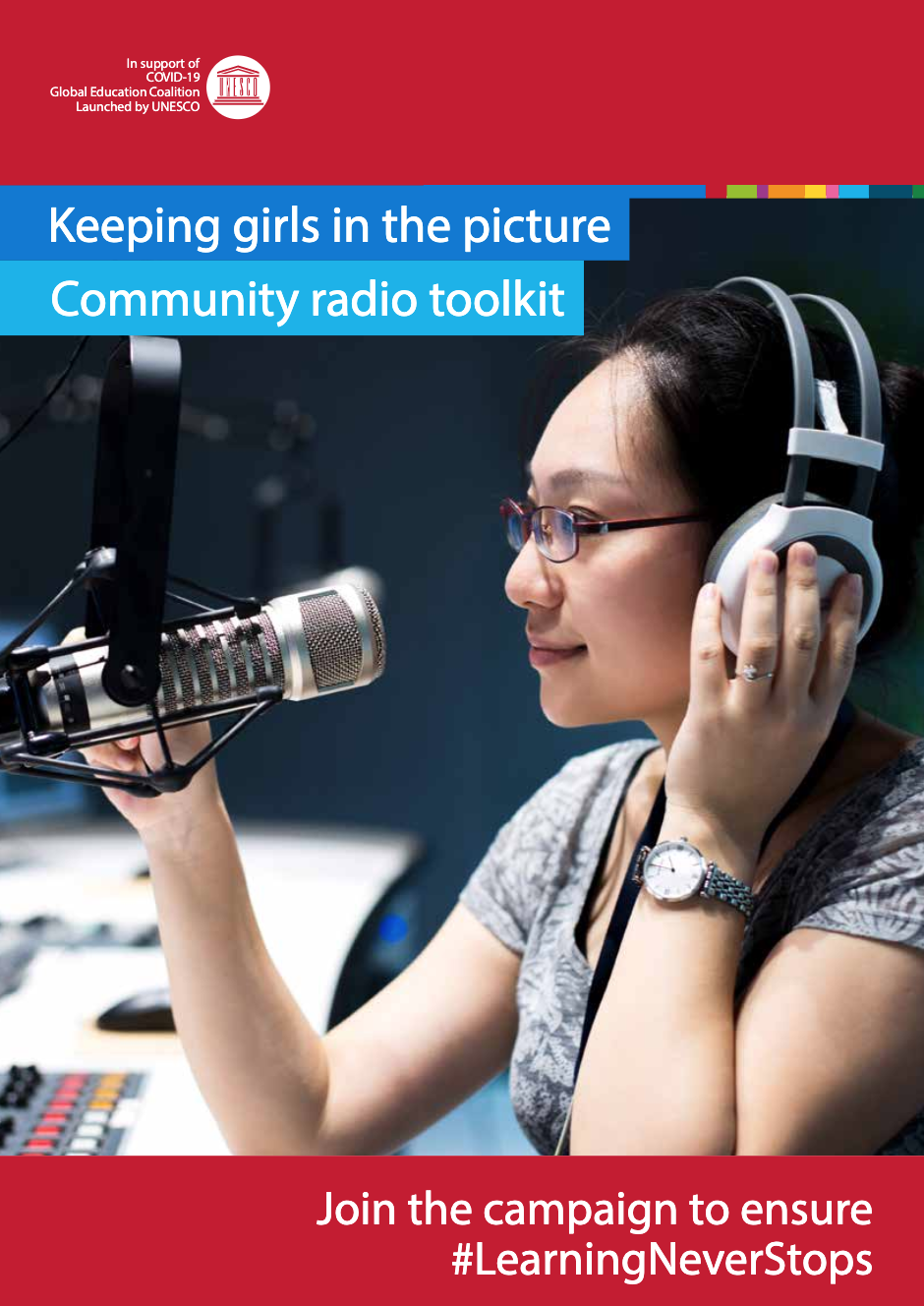
Author: UNESCO and Global Education Coalition
Audience: Policymakers
Languages: English
Geographical Scope: Regional
This toolkit is to help you to get stories and messages about this vital issue out to your audience. We want it to make an impact on people’s lives. We hope this toolkit will support you in creating exciting and memorable content for community radio programmes wherever you are.


